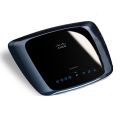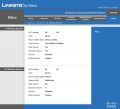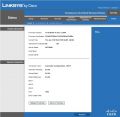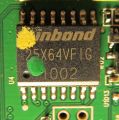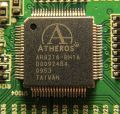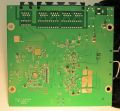Manuf (OEM/ODM): Gemtek WRTA-244N
FCC approval date: 09 January 2009
UPC: 745883587094 (UPC DB, On eBay)
Country of manuf.: China
S/N prefix: MUJ0
Power: 12 VDC, 1.5 A
Connector type: barrel
CPU1: Atheros AR7161 (680 MHz)
FLA1: 8 MiB8,388,608 B <br />65,536 Kib <br />8,192 KiB <br />64 Mib <br />0.00781 GiB <br /> (Winbond W25X64VFIG)
RAM1: 32 MiB33,554,432 B <br />262,144 Kib <br />32,768 KiB <br />256 Mib <br />0.0313 GiB <br /> (Winbond W9425G6EH-5)
Expansion IFs: none specified
WI1 chip1: Atheros AR9223
WI1 802dot11 protocols: bgn
WI1 MIMO config: 2x2:2
WI1 antenna connector: none
WI2 chip1: Atheros AR9220
WI2 802dot11 protocols: an
WI2 MIMO config: 2x2:2
WI2 antenna connector: U.FL
ETH chip1: Atheros AR7161
Switch: Atheros AR8216
LAN speed: 100M
LAN ports: 4
WAN speed: 100M
WAN ports: 1
Additional chips
2.4GHz Power Amplifier IC;Microsemi;LX5511;MSC, 5511, 004F;2;
4.9 to 5.9GHz Power Amplifier IC;Microsemi;LX5530;MSC, 5530, 002C;2;InGaP/GaAs HBT;3 mm x 3 mm;
3A, 18V, 340KHz Synchronous Rectified Step-Down Converter;MPS;MP1484;MP1484EN, 97721307, MPS042;1;SOIC8N;
For a list of all currently documented Atheros (QCA) chipsets with specifications, see Atheros.
Simultaneous Dual-Band Wireless-N Router
- • Support page • (Template link outdated)
- OEM: Gemtek WRTA-244N (WRTA-244N_V02)
The power adapter included with the device is a
- Leader Electronics MU18-D120150-A1 (12V, 1.5A).
Links of Interest
Flashing
 | NOTE: During configuration or flashing a device, the only things that should be hooked to the device is the computer and power. |
Flashing DD-WRT
 | WARNING: Do not flash micro this unit! |
- Linksys WRT400N
- DD-WRT nvram=64
Files needed:
- Do a Hard reset or 30/30/30 on the router
- Set a static IP on your computer to 192.168.1.7. Subnet mask should be 255.255.255.0.
- Connect the lan cable from your computer to a LAN port of your router. Make sure your router is plugged in. Nothing should be connected to your computer or the router except the lan cable between them. Turn your firewall and any wireless computer connections OFF.
- Power cycle the router (uplug the power from the router for 30 seconds and then plug it back in)
- Open your browser to 192.168.1.1 by putting that in the browser address window of your browser. You should open the linksys webgui and NOT a page that says Management Mode. If you see management mode, power cycle the router again.
- Leave the username blank and enter "admin" as the password
- Go to administration and firmware upgrade
- Navigate to the folder that you are using, and select linksys-to-ddwrt-firmware.bin
- Hit upgrade
- When you get a success, wait FIVE FULL minutes.
- If you don't get success, repeat from steps 6 up to this one. If you still don't get success, clear your browser cache. Try using a different browser as well, to navigate to 192.168.1.1.
- When you can access the dd-wrt webgui using a browser at 192.168.1.1, power cycle the router.
- When you can again access the dd-wrt webgui using a browser at 192.168.1.1, do another Hard reset or 30/30/30 on the router.
- Go to administration and firmware upgrade
- Navigate to the folder that you are using, and select wrt400n-firmware.bin
- Hit upgrade
- When you get a success, wait FIVE FULL minutes.
- At this point you can choose to put a different build on, depending on what you needs are.
- Reset your computer ethernet connection to auto IP and auto DNS
Flashing OpenWRT
Flashing Gargoyle
Upgrading
Updating DD-WRT
If dd-wrt is already on the router follow these instructions. If stock firmware is on the router follow the flashing instructions.
- Check for recommended builds here first.
- Set your computer to a static IP of 192.168.1.7. (or to whatever subnet the router is on) Disable all firewalls and security. Disable wireless on your computer and only have the router connected to the flashing computer by the ethernet cable between the two.
- Hard reset or 30/30/30 (If the router supports it, if not, reset to defults in the GUI) prior to flashing. Wait. Check for password page on re-login and change password.
- Flash firmware. You can use the webgui except if you have a belkin router. (For belkin use tftp.exe to flash)
- Wait...at least three minutes. Lights should return to normal. See important2, below. Failing to wait is how most people brick their routers.
- Do a power cycle of the router. (Unplug the cord, count to 30 and plug it back in.)
- Wait for the lights to return to normal usually about 2 minutes.
- Hard reset or 30/30/30 again (If the router supports it, if not, reset to defults in the GUI). Wait. Check for the password page and re-login to change the password. Then you can reconfigure your settings manually.
- Once configured set your computer back to autoIP and autoDNS.
Important1: This Hard reset or 30/30/30 works fine for Asus router, but you do have to power cycle after the reset.
Important2: After you flash the firmware, and before you do the hard reset, the router will be building some nvram settings. YOU MUST WAIT FOR THIS TO FINISH PRIOR TO DOING ANYTHING WITH THE ROUTER INCLUDING A HARD RESET. Usually, you can tell when this process is completed by the WAN light coming on, but it does take several minutes. Go have a beer. There are starting to be more and more people who BRICK their routers by not waiting until the nvram is rebuilt, PRIOR to doing a hard reset. YOU NEED TO WAIT!
Reverting
Reverting to OEM Firmware from DD-WRT
TFTP Revert
TFTP flash revert reported working by LOM
GUI Revert
Special thx to LOM, who created the file.
- Restore factory defaults via dd-wrt GUI.
- Set static IP address to 192.168.1.10
- Goto firmware upgrade, click browse, find the revert file WRT400N_webrevert.bin, click upgrade.
- IMPORTANT: wait 5 minutes
- Enter 192.168.1.1 in the web browser.
- At the prompt, leave the username blank and enter "admin" w/o the quotes as the password.
- Don't forget to set your IP back to Obtain an IP address automatically.
JTAG-Serial Info
JTAG
JTAG Pinouts
nTRST 1o o2 GND
TDI 3o o4 GND
TDO 5o o6 GND
TMS 7o o8 GND
TCK 9o o10 GND
nSRST 11o o12 N/C
N/C 13o o14 N/C
Serial
Serial Pinouts
GND 4 o
TX 3 o
RX 2 o
VCC 1 o
Hyper terminal Setup in Windows XP
In Windows XP, Click Start Button - All Programs - Accessories -
Communication - HyperTerminal
Enter a name for the connection, Click ok
Choose com port you adapter is plugged into, Click ok
Set:
Bits per second = 115200
Data Bits = 8
Parity = none
Stop bits = 1
Flow control = none
Click ok
Click File - Save As, and select a place to save it to so you
don't have to enter the settings again.
Putty Setup in Windows XP
After installing putty, run it
Serial line = The COM port your using for serial (ie. COM3)
Speed = 115200
Click on Serial under Connection
Serial line to connect to = same as above (Serial line)
Speed (baud) = 115200
Data bits = 8
Stop bits = 1
Parity = none
Flow control = none
Click Session
Enter a name for your connection under saved sessions
Click Save
Click Open
DD-WRT Serial Recovery
To recover from a bad flash and get back to DD-WRT.....
Download openwrt-to-dd-wrt.bin, Don't worry about the name, it will get you back to DD-WRT.
Download TFTP32
Configure PC to 192.168.1.88
Install TFTP32
Set it up as server, browse to where the recovery file is.
Then in telnet(putty or hyper terminal) enter
tftpboot 0x80010000 openwrt-to-dd-wrt.bin
and if you get a successful tftp transfer then:
erase 0xbf040000 +0x600000
cp.b 0x80010000 0xbf040000 0x600000
Then enter
boot
USB Info
No USB
Pictures
Cisco's ImagesDarkShadow's UnitM86's Unit
FCCID Q87-WRT400N
Notes
DD-WRT Notes
Known DD-WRT Issues
Running dd-wrt 14144
- Still has constantly blinking wireless LED Ticket #1420
- Still has LAN MAC sudo matching ath1's MAC Ticket #1435
- Security LED still doesn't come on when security is set Ticket #1434
- Site Survey for ath0 shows double and triple the SSID's for the same MAC address Ticket #1431
- TX Power setting have no affect Ticket #1433
- 5 GHz rate always says auto rather then actually speed Ticket #1436
- Site Survey now works for ath1 (5 GHz)
Running dd-wrt 14039
- Lan Speed Test Results (if setting is not listed it is default)
- 5 GHz - ath1
- Wireless Network Mode - N-Only (5 GHz)
- Channel Width - Turbo (40 MHz)
- Control Channel - upper
Laptop w/ Linksys WPC600N
Writing---------------Reading
Packet Length:-------104,857,600------104,857,600
Time to complete:----17.3910000-------29.7180000
Bytes Per Second:----6,029,418--------3,528,420
Bits Per Seecond:----48,235,344-------28,227,360
Mbps:----------------46.0008087-------26.9197083
Problems Seen thus far on dd-wrt...
- MAC address on mine are screwed up like my wrt600n. wl1 and LAN MAC are the same. They weren't in the Linksys firmware.
- The wireless led on solid
- Posting across 2.4 GHz Client Bridge right now. Bridged to wrt600n.
- 5 GHz Client Bridge very unstable, won't maintain connection with wrt600n. Keeps changing the channel when reconnecting. Maybe result of reconnection.
- Upgrade went smooth. Haven't tested client connections to the wrt400n.
- Wireless Security LED doesn't come on when security is set.
- 5 GHz is lacking channels when set as AP
Collected Info
| ExpandBoot Log
|
U-Boot 1.1.4 (Oct 22 2008 - 12:35:32)
AP94 (ar7100) U-boot 0.0.12
DRAM: b8050000: 0xc0140180
32 MB
Top of RAM usable for U-Boot at: 82000000
Reserving 4308k for U-Boot at: 81bc8000
Reserving 192k for malloc() at: 81b98000
Reserving 44 Bytes for Board Info at: 81b97fd4
Reserving 36 Bytes for Global Data at: 81b97fb0
Reserving 128k for boot params() at: 81b77fb0
Stack Pointer at: 81b77f98
Now running in RAM - U-Boot at: 81bc8000
id read 0x100000ff
flash size 8MB, sector count = 128
Flash: 8 MB
In: serial
Out: serial
Err: serial
Net: ag7100_enet_initialize...
No valid address in Flash. Using fixed address
eth0: 00:00:00:00:00:00
eth0 up
No valid address in Flash. Using fixed address
eth1: 00:00:00:00:00:00
eth1 up
eth0, eth1
Press CTRL+C to stop autoboot: 0
## Booting image at bf040000 ...
Image Name: Linux Kernel Image
Created: 2008-12-24 4:42:08 UTC
Image Type: MIPS Linux Kernel Image (lzma compressed)
Data Size: 886355 Bytes = 865.6 kB
Load Address: 80002000
Entry Point: 8026c000
Verifying Checksum ... OK
Uncompressing Kernel Image ... OK
No initrd
## Transferring control to Linux (at address 8026c000) ...
## Giving linux memsize in bytes, 33554432
Starting kernel ...
Linux version 2.6.15--LSDK-7.3.0.268 (marmot@localhost.localdomain) (gcc version
3.4.4) #1 Wed Dec 24 12:14:33 CST 2008
flash_size passed from bootloader = 8
arg 1: console=ttyS0,115200
arg 2: root=31:03
arg 3: rootfstype=squashfs
arg 4: init=/sbin/init
arg 5: mtdparts=ar7100-nor0:192k(uboot),64k(env),1280k(linux),6336k(rootfs),64k(
nvram),64k(factory),128k(language),64k(caldata)
CPU revision is: 00019374
Determined physical RAM map:
memory: 02000000 @ 00000000 (usable)
Built 1 zonelists
Kernel command line: console=ttyS0,115200 root=31:03 rootfstype=squashfs init=/s
bin/init mtdparts=ar7100-nor0:192k(uboot),64k(env),1280k(linux),6336k(rootfs),64
k(nvram),64k(factory),128k(language),64k(caldata)
Primary instruction cache 64 {{abbr|kb|kilobytes}}, physically tagged, 4-way, linesize 32 bytes.
Primary data cache 32kB, 4-way, linesize 32 bytes.
Synthesized TLB refill handler (20 instructions).
Synthesized TLB load handler fastpath (32 instructions).
Synthesized TLB store handler fastpath (32 instructions).
Synthesized TLB modify handler fastpath (31 instructions).
Cache parity protection disabled
PID hash table entries: 256 (order: 8, 4096 bytes)
Using 340.000 MHz high precision timer.
Console: colour dummy device 80x25
Dentry cache hash table entries: 8192 (order: 3, 32768 bytes)
Inode-cache hash table entries: 4096 (order: 2, 16384 bytes)
Memory: 29476k/32768k available (2060k kernel code, 3276k reserved, 407k data, 1
52k init, 0k highmem)
Mount-cache hash table entries: 512
Checking for 'wait' instruction... available.
NET: Registered protocol family 16
AR7100 GPIOC major 0
squashfs: version 3.1 includes LZMA decompression support (2006/08/29) Phillip L
ougher
Initializing Cryptographic API
io scheduler noop registered
io scheduler deadline registered
Serial: 8250/16550 driver $Revision: #1 $ 1 ports, IRQ sharing disabled
serial8250.0: ttyS0 at MMIO 0x0 (irq = 19) is a 16550A
RAMDISK driver initialized: 1 RAM disks of 1024K size 1024 blocksize
PPP generic driver version 2.4.2
PPP Deflate Compression module registered
PPP BSD Compression module registered
PPP MPPE Compression module registered
NET: Registered protocol family 24
8 cmdlinepart partitions found on MTD device ar7100-nor0
Creating 8 MTD partitions on "ar7100-nor0":
0x00000000-0x00030000 : "uboot"
0x00030000-0x00040000 : "env"
0x00040000-0x00180000 : "linux"
0x00180000-0x007b0000 : "rootfs"
0x007b0000-0x007c0000 : "nvram"
0x007c0000-0x007d0000 : "factory"
0x007d0000-0x007f0000 : "language"
0x007f0000-0x00800000 : "caldata"
u32 classifier
Perfomance counters on
OLD policer on
NET: Registered protocol family 2
IP route cache hash table entries: 512 (order: -1, 2048 bytes)
TCP established hash table entries: 2048 (order: 1, 8192 bytes)
TCP bind hash table entries: 2048 (order: 1, 8192 bytes)
TCP: Hash tables configured (established 2048 bind 2048)
TCP reno registered
ip_conntrack version 2.4 (256 buckets, 2048 max) - 224 bytes per conntrack
init NAT GRE
ip_conntrack_rtsp v0.6.21 loading
ip_nat_rtsp v0.6.21 loading
ip_ct_h323: init success
ip_conntrack_pptp version 3.0 loaded
ip_nat_h323: init success
ip_nat_pptp version 3.0 loaded
ip_tables: (C) 2000-2002 Netfilter core team
ipt_AUTOFW loading
ipt_trigger : register proc success
ipt_time loading
TCP bic registered
NET: Registered protocol family 1
NET: Registered protocol family 10
lo: Disabled Privacy Extensions
IPv6 over IPv4 tunneling driver
NET: Registered protocol family 17
802.1Q VLAN Support v1.8 Ben Greear <greearb@candelatech.com>
All bugs added by David S. Miller <davem@redhat.com>
VFS: Mounted root (squashfs filesystem) readonly.
Freeing unused kernel memory: 152k freed
Warning: unable to open an initial console.
waitpid: No child processes
brctl addbr br0: No child processes
et0macaddr 00:25:9C:7B:58:AF
SIOCSIFHWADDRwaitpid: No child processes
lan_config hw ether up: No child processes
waitpid: No child processes
ifconfig, br0: No child processes
waitpid: No child processes
brctl addbr br0: No child processes
ARPING to 192.168.1.1 from 192.168.1.1 via br0
Sent 1 probes (1waitpid: No child processes
wan_deconfig: No child processes
waitpid: No child processes
wan_config ether fail: No child processes
waitpid: No child processes
wan_config mtu up: No child processes
athstats
80211stats
wlanconfig
pktlogconf
pktlogdump
radartool
ret is 0, ssid dh400 2.4 {{abbr|GHz|gigahertz}}, new_ssid wrt400 2.4 {{abbr|GHz|gigahertz}}
ret is 0, ssid dh400 5 {{abbr|GHz|gigahertz}}, new_ssid wrt400 5 {{abbr|GHz|gigahertz}}
Args: 1
Creating ap for wrt400 2.4 {{abbr|GHz|gigahertz}} on
Added ath0 mode master
The command noedgech needs exactly 1 argument(s)...
Invalid command : ampdumin
Created ath0 mode ap for wrt400 2.4 {{abbr|GHz|gigahertz}}
lo no wireless extensions.
sit0 no wireless extensions.
ip6tnl0 no wireless extensions.
eth0 no wireless extensions.
eth1 no wireless extensions.
br0 no wireless extensions.
wifi0 no wireless extensions.
wifi1 no wireless extensions.
arping: bind
Error for wireless request "Minimum RTS Threshold should be 256 bytes" (8B22) :
invalid argument "0".
Modules already loaded
Creating ap for wrt400 5 {{abbr|GHz|gigahertz}} on
Added ath1 mode master
The command noedgech needs exactly 1 argument(s)...
Invalid command : ampdumin
Created ath1 mode ap for wrt400 5 {{abbr|GHz|gigahertz}}
lo no wireless extensions.
sit0 no wireless extensions.
ip6tnl0 no wireless extensions.
eth0 no wireless extensions.
eth1 no wireless extensions.
br0 no wireless extensions.
wifi0 no wireless extensions.
wifi1 no wireless extensions.
arping: bind
Error for wireless request "Minimum RTS Threshold should be 256 bytes" (8B22) :
invalid argument "0".
wl0_macaddr 00:00:00:00:00:00
wl1_macaddr 00:00:00:00:00:00
iptables: waitpid: No child processes
/bin/shwaitpid: No child processes
g_wl_interface is ath0
BusyBox v1.01 (2008.12.24-04:42+0000) Built-in shell (ash)
Enter 'help' for a list of built-in commands.
/ # (nvram_unset)exclusive zone
shared_nvram->writing 1
l2_packet_receive - recvfrom: Network is down
l2_packet_receive - recvfrom: Network is down
|
| Expandifconfig
|
/sbin # ifconfig
ath0 Link encap:Ethernet HWaddr 00:00:00:00:00:00
inet6 addr: 0000::000:0000:0000:0000/64 Scope:Link
UP BROADCAST RUNNING MULTICAST MTU:2290 Metric:1
RX packets:0 errors:0 dropped:0 overruns:0 frame:0
TX packets:0 errors:0 dropped:102 overruns:0 carrier:0
collisions:0 txqueuelen:1000
RX bytes:0 (0.0 B) TX bytes:0 (0.0 B)
ath1 Link encap:Ethernet HWaddr 00:00:00:00:00:00
inet6 addr: 0000::000:0000:0000:0000/64 Scope:Link
UP BROADCAST RUNNING MULTICAST MTU:2290 Metric:1
RX packets:0 errors:0 dropped:0 overruns:0 frame:0
TX packets:0 errors:0 dropped:105 overruns:0 carrier:0
collisions:0 txqueuelen:1000
RX bytes:0 (0.0 B) TX bytes:0 (0.0 B)
br0 Link encap:Ethernet HWaddr 00:00:00:00:00:00
inet addr:192.168.13.1 Bcast:192.168.13.255 Mask:255.255.255.0
inet6 addr: 0000::000:00:0000:0/64 Scope:Link
UP BROADCAST RUNNING MULTICAST MTU:1500 Metric:1
RX packets:388 errors:0 dropped:0 overruns:0 frame:0
TX packets:272 errors:0 dropped:0 overruns:0 carrier:0
collisions:0 txqueuelen:0
RX bytes:49352 (48.1 KiB) TX bytes:101485 (99.1 KiB)
eth0 Link encap:Ethernet HWaddr 00:00:00:00:00:00
inet6 addr: fe80::225:9cff:fe7b:58af/64 Scope:Link
UP BROADCAST MULTICAST MTU:1500 Metric:1
RX packets:391 errors:0 dropped:0 overruns:0 frame:0
TX packets:198 errors:0 dropped:0 overruns:0 carrier:0
collisions:0 txqueuelen:1000
RX bytes:55810 (54.5 KiB) TX bytes:76591 (74.7 KiB)
eth1 Link encap:Ethernet HWaddr 00:00:00:00:00:00
UP BROADCAST MULTICAST MTU:1500 Metric:1
RX packets:0 errors:0 dropped:0 overruns:0 frame:0
TX packets:0 errors:0 dropped:0 overruns:0 carrier:0
collisions:0 txqueuelen:1000
RX bytes:0 (0.0 B) TX bytes:0 (0.0 B)
lo Link encap:Local Loopback
inet addr:127.0.0.1 Mask:255.0.0.0
inet6 addr: ::1/128 Scope:Host
UP LOOPBACK RUNNING MULTICAST MTU:16436 Metric:1
RX packets:0 errors:0 dropped:0 overruns:0 frame:0
TX packets:0 errors:0 dropped:0 overruns:0 carrier:0
collisions:0 txqueuelen:0
RX bytes:0 (0.0 B) TX bytes:0 (0.0 B)
wifi0 Link encap:UNSPEC HWaddr 00-00-00-00-00-00-00-00-00-00-00-00-00-00-00-00
UP BROADCAST RUNNING MULTICAST MTU:1500 Metric:1
RX packets:0 errors:0 dropped:0 overruns:0 frame:0
TX packets:0 errors:93 dropped:0 overruns:0 carrier:0
collisions:0 txqueuelen:1000
RX bytes:0 (0.0 B) TX bytes:0 (0.0 B)
Interrupt:48 Memory:b0000000-b0010000
wifi1 Link encap:UNSPEC HWaddr 00-00-00-00-00-00-00-00-00-00-00-00-00-00-00-00
UP BROADCAST RUNNING MULTICAST MTU:1500 Metric:1
RX packets:0 errors:0 dropped:0 overruns:0 frame:0
TX packets:0 errors:0 dropped:0 overruns:0 carrier:0
collisions:0 txqueuelen:1000
RX bytes:0 (0.0 B) TX bytes:0 (0.0 B)
Interrupt:49 Memory:b0010000-b0020000
/sbin #
|
| Expandiwconfig
|
/sbin # iwconfig
lo no wireless extensions.
sit0 no wireless extensions.
ip6tnl0 no wireless extensions.
eth0 no wireless extensions.
eth1 no wireless extensions.
br0 no wireless extensions.
wifi0 no wireless extensions.
wifi1 no wireless extensions.
ath0 IEEE 802.11ng ESSID:"dh400 2.4 {{abbr|GHz|gigahertz}}"
Mode:Master Frequency:2.462 GHz Access Point: 00:00:00:00:00:00
Bit Rate:0 kb/s Tx-Power=12 dBm Sensitivity=1/3
Retry:off RTS thr:off Fragment thr:off
Encryption key:21FB-B084-48A7-01CD-7B43-08D7-47B7-30B8 [2] Security
mode:open
Power Management:off
Link Quality=0/94 Signal level=161/162 Noise level=161/161
Rx invalid nwid:2525 Rx invalid crypt:0 Rx invalid frag:0
Tx excessive retries:0 Invalid misc:0 Missed beacon:0
ath1 IEEE 802.11na ESSID:"dh400 5 {{abbr|GHz|gigahertz}}"
Mode:Master Frequency:5.745 {{abbr|GHz|gigahertz}} Access Point: 00:00:00:00:00:00
Bit Rate:0 kb/s Tx-Power=14 dBm Sensitivity=1/3
Retry:off RTS thr:off Fragment thr:off
Encryption key:1779-822D-A53C-8959-8D85-D4EC-1865-0846 [2] Security
mode:open
Power Management:off
Link Quality=0/94 Signal level=161/162 Noise level=161/161
Rx invalid nwid:0 Rx invalid crypt:0 Rx invalid frag:0
Tx excessive retries:0 Invalid misc:0 Missed beacon:0
/sbin #
|
| Expandother
|
ar7100> imls
Image at BF040000:
Image Name: Linux Kernel Image
Created: 2008-12-24 4:42:08 UTC
Image Type: MIPS Linux Kernel Image (lzma compressed)
Data Size: 886355 Bytes = 865.6 kB
Load Address: 80002000
Entry Point: 8026c000
Verifying Checksum ... OK
/proc # cat cmdline
console=ttyS0,115200 root=31:03 rootfstype=squashfs init=/sbin/init mtdparts=ar7
100-nor0:192k(uboot),64k(env),1280k(linux),6336k(rootfs),64k(nvram),64k(factory)
,128k(language),64k(caldata)
/proc # cat cpuinfo
system type : Atheros AR7100 (hydra)
processor : 0
cpu model : MIPS 24K V7.4
BogoMIPS : 451.58
wait instruction : yes
microsecond timers : yes
tlb_entries : 16
extra interrupt vector : yes
hardware watchpoint : yes
ASEs implemented : mips16
VCED exceptions : not available
VCEI exceptions : not available
/proc # lsmod
Module Size Used by Tainted: P
wlan_scan_ap 9408 1 - Live 0xc005e000
ath_pktlog 15424 0 - Live 0xc0059000
wlan_me 10176 0 - Live 0xc0026000
wlan_acl 4576 2 - Live 0xc004f000
wlan_wep 6112 0 - Live 0xc004c000
wlan_tkip 13408 0 - Live 0xc002e000
wlan_ccmp 8608 2 - Live 0xc002a000
wlan_xauth 1344 0 - Live 0xc0024000
ath_pci 60224 0 - Live 0xc0062000
ath_dev 133616 2 ath_pktlog,ath_pci, Live 0xc0112000
ath_dfs 38976 1 ath_dev, Live 0xc0041000
ath_rate_atheros 49424 2 ath_pktlog,ath_dev, Live 0xc0033000
wlan 262048 12 wlan_scan_ap,ath_pktlog,wlan_me,wlan_acl,wlan_wep,wlan_tkip,wlan_
ccmp,wlan_xauth,ath_pci,ath_dev, Live 0xc00d1000
ath_hal 315776 6 ath_pktlog,ath_pci,ath_dev,ath_dfs, Live 0xc0082000
WRT400N_gpio_mod 4640 0 - Live 0xc000f000
WRT400N_led_wsc_mod 5472 0 - Live 0xc000c000
ag7100_mod 32624 0 - Live 0xc001b000
/proc # cat mtd
dev: size erasesize name
mtd0: 00030000 00010000 "uboot"
mtd1: 00010000 00010000 "env"
mtd2: 00140000 00010000 "linux"
mtd3: 00630000 00010000 "rootfs"
mtd4: 00010000 00010000 "nvram"
mtd5: 00010000 00010000 "factory"
mtd6: 00020000 00010000 "language"
mtd7: 00010000 00010000 "caldata"
/proc # cat pci
PCI devices found:
Bus 0, device 0, function 0:
Class ffff: PCI device 168c:0029 (rev 255).
IRQ 48.
Master Capable. Latency=168.
Non-prefetchable 32 bit memory at 0x10000000 [0x1000ffff].
Bus 0, device 1, function 0:
Class 0280: PCI device 168c:0029 (rev 1).
IRQ 49.
Master Capable. Latency=168.
Non-prefetchable 32 bit memory at 0x10010000 [0x1001ffff].
/proc # ps
PID Uid VmSize Stat Command
1 root 1060 S /sbin/init
2 root SWN [ksoftirqd/0]
3 root SW< [events/0]
4 root SW< [khelper]
5 root SW< [kthread]
6 root SW< [kblockd/0]
7 root SW [pdflush]
8 root SW [pdflush]
10 root SW< [aio/0]
9 root SW [kswapd0]
11 root SW [mtdblockd]
13 root 340 S /sbin/syslogd -n
1053 root 636 S /bin/httpd
1062 root 648 S /bin/udhcpd /tmp/udhcpd.conf
1063 root 240 S matrixtunnel -d 443 -r 80 -A /etc/certSrv.pem -p /etc
1069 nobody 348 S dnsmasq
1077 root 468 S /bin/sh
1079 root 280 S lld2d br0
1082 root 612 S hostapd /tmp/topology.conf
1091 root 288 S /sbin/hnapssdp
1093 root 348 R ps
|
Hardware Modification
Antenna Mod
Note: This is for 5 GHz band only. The 2.4 GHz band antenna wires are soldered to the board.

